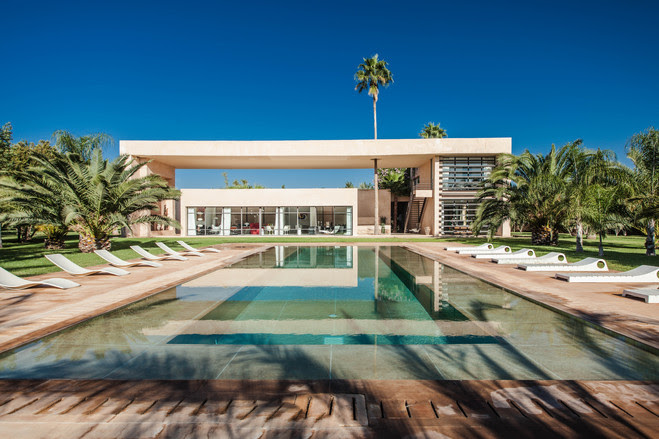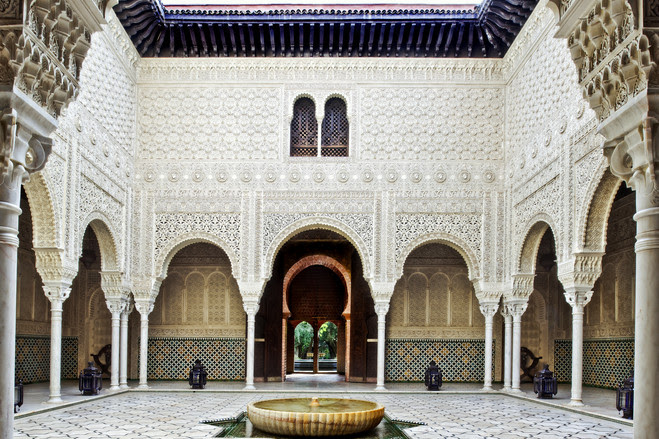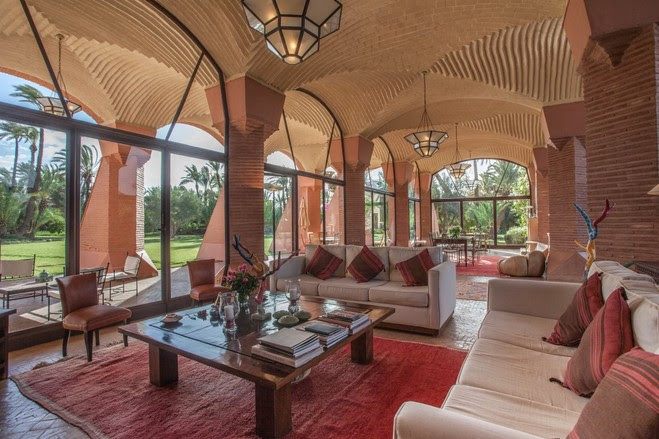The wall street journal
Ultraluxurious homes within a 54-square-mile palm grove called La Palmeraie are a mashup of modern and Moroccan; the Emir of Qatar and members of the Agnelli and Hermès families have homes.
Ruth Bloomfield.
On the northern fringes of Marrakesh, overlooked by the Atlas Mountains, luxury hotels and vast mansions sit within a natural 54-square-mile palm grove called La Palmeraie.
Notable residents of this rarefied Moroccan enclave include the Emir of Qatar, who paid a reported $117.7 million for his vacation home. Marella Agnelli, widow of Fiat chairman Gianni Agnelli, and Dominique Strauss-Kahn, the former director of the International Monetary Fund, also have homes here. Fashion magnate Patrick Guerrand-Hermès spends part of the year in Morocco, and founded the Royal Polo Club de la Palmeraie.
Not all residents are billionaires. Potential buyers might manage to pick up a small villa in La Palmeraie for $1 million, said Alex Peto, partner at Kensington Luxury Properties, Christie’s International Real Estate’s affiliate in Morocco. But it would take a budget of $5.88 million to pick up a six-bedroom, 13,000- to 15,000-square-foot home. It would likely come with around 2.5 acres of land, with a pool, hammam (a traditional steam bath) and staff quarters.
A camel awaits tourists in an oasis outside the walls of La Palmeraie. Photo: James Rajotte for The Wall Street Journal
A modern home in La Palmeraie currently listed for about $2.96 million. Photo: Emile Garcin Properties
One can, of course, spend far, far more.
Mr. Peto is currently listing a $65.83 million, 59,632-square-foot behemoth of a house, with eight bedrooms and 16 bathrooms, and a design based on the Alhambra Palace, the fabulous 13th-century palace and fort in Spain.
Its interiors make the most of traditional Moroccan craftsmanship, with cedar-wood ceilings and ornately tiled internal courtyard and reception rooms, while its 11-acre backyard features a swimming pool, network of lakes and a rose garden and cacti garden.
Across La Palmeraie, houses are mostly a mashup of traditional Moroccan style and European modernism, combining traditional finishes like mosaic and tadelakt (a form of polished plaster), with a muted color scheme, and rooms with high ceilings and large windows. Kitc
A traditional Moroccan home listed for $65.88 million.Photo: Kensington Luxury Properties
The oldest homes in the neighborhood date from the French rule of Morocco (a large tranche of the country was a French protectorate from 1912 until independence in 1955), but Mr. Amar said the majority have been built over the past 20 years. Owners of these homes have added personal touches, from polo fields to private golf courses.
Although sections of La Palmeraie are protected from further development, individual building lots are still available, as well as space for larger projects. Most notably, a Ritz-Carlton hotel, spa, polo club and 85 residences are currently under construction on a 124-acre site.
Overseas buyers are attracted by Marrakesh’s climate—it barely has a winter; even in January, the city logs seven hours of sunshine daily, according to the Met Office, the British official meteorological service. It is also accessible. A flight from London takes less than four hours. From New York, there’s a direct flight to Casablanca, followed by a brief flight to Marrakesh.
A home that mixes modern and Moroccan, listed for about $2.96 million. Photo: Emile Garcin Properties.
“They buy so they can come in wintertime when the weather is nice,” said Mr. Amar. “We are really close from Europe but 15 degrees warmer. A lot of people come just for the weekend; you do not get jet lag and it is very exotic.”
There are no restrictions on foreign buyers in Morocco. Buying costs—including agents’ fees, legal fees, and taxes—come in at around 10% of sale price. There are no wealth taxes, and annual fees to the local councils are minimal. For a big house it is around $3,500 a year, said Ms. Fajas. Sales tax on second homes are either 3% if the property has not increased in value or 20% of profit if it has, whichever is higher.
Like Europe and North America—and perhaps because of its reliance on overseas buyers—these prime Marrakesh neighborhoods have had an up-and-down decade. Although there is no official monitor of prices Mr. Amar estimates that values increased by around 20% per year between 2000 and 2004, settling slightly to 15% per year between 2005 and 2007.
In the aftermath of the global economic crisis of 2007, prices began to fall. Three years later Marrakesh was hit by the Arab Spring, though it did not experience any unrest. As a result Mr. Peto estimates its luxury market fell by “at least 30%” between then and 2015.
Since then the market has slowly stabilized. “Time is a great healer,” said Mr. Peto.
Ms. Fajas sees the current state of play as a return to normalcy. “I think that the prices will not go back up because customers now understand the market price,” she said. “Before everyone was over-excited, but now they know the real price.”











